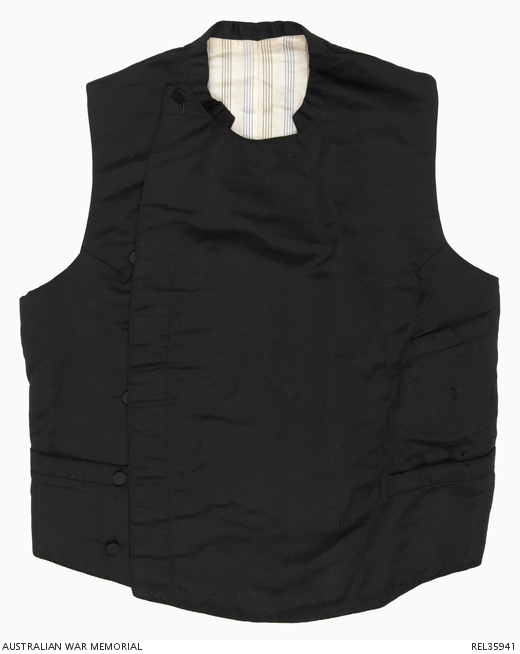| Places | |
|---|---|
| Accession Number | REL35941 |
| Collection type | Heraldry |
| Object type | Heraldry |
| Physical description | Celluloid, Cotton, Metal, Silk |
| Maker |
J Wippell & Co Ltd |
| Place made | United Kingdom: England, Greater London, London |
| Date made | 1913 |
| Conflict |
Period 1910-1919 First World War, 1914-1918 |
Full dress cassock waistcoat : Chaplain V A S Little, RAN

Corded black silk waistcoat with 18 mm high stand collar cut away at the front to allow a white clerical collar to be seen. The lower front is cut in a curve below the line of the waist. The waistcoat fastens down the right side with six buttons covered with plain weave black silk; the top button at the neck is visible when the waistcoat is fastened, while the other five are concealed. There are three welt pockets, one each on either side of the waist and one at the left breast. The back of the waistcoat is made from a black cotton and wool twill fabric. It has an inverted ' V' notch at the bottom of the centre back and the fit can be adjusted by a self fabric strap and black painted metal buckle. A manufacturer's label for' J. Wippel & Co. Ltd, Exeter & London', dated 1913, is sewn inside the strap. The waistcoat is lined with fine cream cotton twill with alternate stripes in brown and blue. Brown celluloid buttons inside the centre neck and lower front waist fasten into concealed button holes in the front panel of the waistcoat to maintain the fit on the wearer.
Worn by Chaplain Vivian Agincourt Spence Little, RAN. Chaplain Little joined the navy as a chaplain in 1913 and was initially posted to HMAS Encounter. A Methodist, he became the first non-Anglican Protestant chaplain to be appointed to the navy. Chaplain Little travelled to England aboard the Encounter to become part of the complement of the newly commissioned light cruiser HMAS Sydney on her maiden voyage to Australia, and remained with the ship until 1917, when he resigned from the RAN. He was serving with the Sydney during its fight with SMS Emden off the Cocos Keeling Islands on 9 November 1914. Chaplains wore a silk cassock waistcoat underneath a clerical Court coat when in full or ball dress.